A new generation of doctor writers is investigating the mysteries of the medical profession, exploring the vital intersection between science and art.
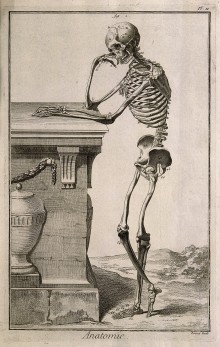
Illustration from Anatomie, by Juan Valverde de Hamusco (Antwerp, 1568). Source: Wellcome Collection.
The language gap frustrates your visit to your doctor. He seems not to understand the problem because you can’t describe it lucidly enough. You don’t understand the proposed treatment because he can’t explain it. I’ve sometimes foresworn medical help because the complexity of voicirng what is wrong has felt heavier than the sickness itself. This is especially true for psychiatric illnesses such as the depression I have experienced, but it is true of physical problems, too. It has been entirely manifest to me when I’ve tried to explain the problem with my left ear, in which I am partially deaf. I’ve said what it feels like, to which my consultant has repeatedly replied with various options. I’ve said it doesn’t feel like any of the things in his multiple-choice list and theorised about what is actually wrong. He has resisted my inexpert opinions, and I have battled with his inability to grasp the subtlety of my experience. We are both articulate and we are both exasperated by this sticky communication.
Language is integral to medicine. It is hard to cure a condition you cannot describe, and few treatments for those conditions go without names of their own. Even veterinarians, trained to diagnose animals who cannot put their complaints into words, begin by labelling the illness and proceed by specifying the treatment. The emerging field of narrative medicine proposes that patients can be treated correctly only when they can tell the story of their illness, often in the context of a more extensive autobiography. A doctor usually begins by getting the patient to describe their pain, and often arrives at diagnosis as much through that interaction as through anything he can observe. Illness is temporal, and language helps to chart its course, even when x-rays, MRIs, CAT scans and other images can represent its current state. A picture is not always worth a thousand words; sometimes, it is the words that tag the problem. You tell the doctor how you felt yesterday and how you feel today; the doctor tells you how you should feel tomorrow. That interaction is part of the cure; it is why a physician’s bedside manner can have such an enormous impact on his efficacy. We are embodied, but our minds order the brokenness around us by imposing vocabulary on it. In fact, there is some evidence that people who can speak more fluently receive better medical care; patients deprived of language are often subject to abuse.
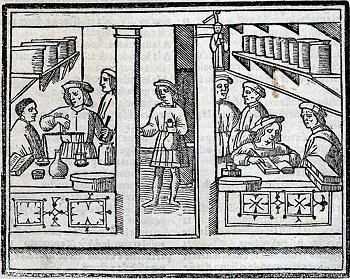
Illustration from title page of Recetario de Galieno by Galen (Italy, 1518). Photo: Wellcome Collection. Source:Wikimedia Commons.
Many of the great doctors have been writers, and those who have not have required writers to set down their insights. Hippocrates, Galen, Maimonides, Paracelsus and Vesalius all left behind chronicles of their work and methods and of the principles driving them. So did historic female doctors such as Trota of Salerno and Hildegard von Bingen, both of whom wrote of their medical work in the 12th century. Medical knowledge is particularly cumulative, and it cannot accrue without words. These doctors’ greatness lay not only in their discernments, but also in their recording of them. Indeed, Galen titled one of his volumes That the Best Physician Is also a Philosopher. The division between humanism and science is recent, an Enlightenment idea, a Cartesian duality, and like many such ideas, it served at first to advance a discourse it may now impede. The two modes of thought are now too often posed as opposites rather than as twin vocabularies for the same reality.
Any serious illness is a medical event, but it is lived in narrative terms. As religion has lost ground to secularism and the split between body and soul has come to feel metaphoric rather than literal, some people have rooted themselves in scientific explanations of the world, while others seek truth in art, literature or even political idealism. Students bifurcate early, pursuing a medical track or a literary/humanist one. It is as though we belong to different races. William Osler, writing in the late 19th century, observed: “It is much more important to know what sort of a patient has a disease than what sort of a disease a patient has.” We have not much heeded his call.
We mustn’t go back to the kind of medicine in which the benign smile of the doctor provides comfort because the cures are somewhere between hypothesis and quackery.
In the heyday of modernism, doctors lionised specialisation, but patients have now turned to holistic approaches that combine oncology, psychiatry, cardiology, neurology and a variety of alternative treatments. After a long period when we focused primarily on depth of knowledge, we have returned to the importance of breadth of knowledge. In telling the stories of illness, we need to tell the stories of the lives within which illness is embedded. Neither humanism nor medicine can explain much without the other, and so many people ricochet between two ways of describing their very being. This is in part because medicine has become so much harder to understand, with its designer molecules, bewildering toxins and digital cameras inserted into parts of ourselves we have never seen, nor wanted to see.
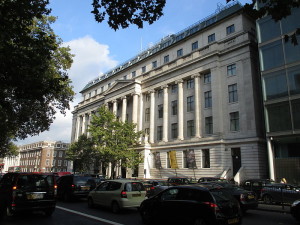
The Wellcome Building, Euston Road, London. Photo: Antiquary. Source: Wikimedia Commons.
On a recent visit to the Wellcome Medical Library in London, I was struck by the diversity of materials in the collection: the notebooks from Victorian asylums with photos of the patients and descriptions of their care; the leaflets distributed by worthy organisations to encourage the sick to avail themselves of medical services; the manuscripts written by medieval physicians; the poetic reflections on health and wholeness that set out to negotiate medicine’s philosophical and moral conundrums. These collections indicate how much writing about science there has always been beyond scientific writing.
But medical writing of today has its own complexion. As medical information has become increasingly technical, patients are asked to trust what they cannot comprehend. Recondite information complicates their already anguished experience of poor health. In a bid for control, such patients seek the logic behind their ailments and the proposed cures. More than that, they seek to use available knowledge to make basic decisions about the value of their own lives and those of the people they love. They need this information in order to resolve dialectical thoughts about mortality and intervention, pleasure and pain, quality and length of life.
A rising literature attempts to reconcile these modes of thought. Voltaire complained, “Doctors are men who prescribe medicines of which they know little, to cure diseases of which they know less, in human beings of whom they know nothing.” But a new run of books attempts to address the last clause of Voltaire’s challenge. Such writings may not be remarkable as either medical information or writing, but they rightly insist that coherence sits at the intersection of science and art. The territory was laid out by a generation of older doctors, including Oliver Sacks, Lewis Thomas and Sherwin Nuland. Echoing Osler, Sacks wrote: “In examining disease, we gain wisdom about anatomy and physiology and biology. In examining the person with disease, we gain wisdom about life.” Sacks’s mission was to describe human beings and all their mucky complexity, not just the defects that had brought them to his notice. His oeuvre has bred a healthy awe of word. “Language, that most human invention,” he wrote, “can enable what, in principle, should not be possible. It can allow all of us, even the congenitally blind, to see with another person’s eyes.”
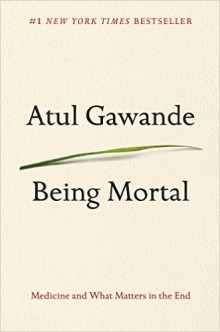
Being Mortal: Medicine and What Matters at the End, by Atul Gawande. New York: Metropolitan Books, 2014.
In the last decade or two, a new generation of doctor writers – including Atul Gawande, Abraham Verghese, Henry Marsh, Danielle Ofri, Siddhartha Mukherjee, Paul Kalanithi and Gavin Francis – have undertaken the mission of seeing in this fashion. For them, the ability to string together twin narratives, that of the doctor and that of the patient, is the only path to truth. The first ingredient in their formula is humility. In Complications: A Surgeon’s Notes on an Imperfect Science, Gawande writes: “We look for medicine to be an orderly field of knowledge and procedure. But it is not. It is an imperfect science, an enterprise of constantly changing knowledge, uncertain information, fallible individuals and, at the same time, lives on the line. There is science in what we do, yes, but also habit, intuition and sometimes plain old guessing. The gap between what we know and what we aim for persists. And this gap complicates everything we do.” Gawande is a man of science, but he refuses to let science rule either his writing or his practice as a physician. Echoing Sacks, he insists that seeing the arc of a patient’s history is crucial to doctoring. In Being Mortal, he writes: “In the end, people don’t view their life as merely the average of all its moments – which, after all, is mostly nothing much plus some sleep. For human beings, life is meaningful because it is a story. A story has a sense of a whole, and its arc is determined by the significant moments, the ones where something happens. Measurements of people’s minute-by-minute levels of pleasure and pain miss this fundamental aspect of human existence … We have purposes larger than ourselves.” Writing in the New Yorker, he explains: “We yearn for frictionless, technological solutions. But people talking to people is still the way norms and standards change.”
Yet the answer to that problem is not to throw away the specialised language, to go back to some kind of gentle, intimate, ignorant medicine, in which the benign smile of the doctor provides comfort because the cures are somewhere between hypothesis and quackery. Verghese, too, writes of the importance of fallibility, of how imperfect thinking is not only inevitable, but also the engine of medicine’s advancement. “I think we learn from medicine everywhere that it is, at its heart, a human endeavour,” he writes in an interview in the San Francisco Chronicle, “requiring good science but also a limitless curiosity and interest in your fellow human being.” That sounds antithetical to the encounters many of us have had with consultants and specialists, but in Verghese’s view, clinical abstraction is a manufactured problem, the consequence of our false presumption that there is such a thing as scientific neutrality. “What we need in medical schools is not to teach empathy, as much as to preserve it,” he writes in the Atlantic. “The process of learning huge volumes of information about disease, of learning a specialised language, can ironically make one lose sight of the patient one came to serve; empathy can be replaced by cynicism.”
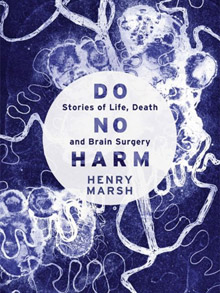
Do No Harm, by Henry Marsh. London: Orion, 2014; New York: Thomas Dunne, 2015.
Marsh, British neurosurgeon and author of Do No Harm: Stories of Life, Death and Brain Surgery (2014), addresses this gap, summoned into it by confronting his own dying mother. “In neuroscience it is called ‘the binding problem’ – the extraordinary fact, which nobody can even begin to explain, that mere brute matter can give rise to consciousness and sensation. I had such a strong sensation, as she lay dying, that some deeper, ‘real’ person was still there behind the death mask.” He observes the intense emotional complexity of surgery that “involved the brain, the mysterious substrate of all thought and feeling … The operation was elegant, delicate, dangerous and full of profound meaning. What could be finer, I thought, than to be a neurosurgeon?” Yet like all surgeons, Marsh is guilty of errors, and it is the human failure more than the scientific one that pains him; he quails at the sight of patients he feels he could and should have served better. He describes one patient to whom he has to deliver the news that there was no longer anything to be done for his brain tumours. “I felt shame, not at my failure to save his life – his treatment had been as good as it could be – but at my loss of professional detachment and what felt like the vulgarity of my distress compared to his composure and his family’s suffering, to which I could only bear impotent witness.” These feelings do not abate with experience, but rather expand. Marsh writes: “I became hardened in the way that doctors have to become hardened [but] now that I am reaching the end of my career this detachment has started to fade.”

What Doctors Feel, by Danielle Ofri. Boston: Beacon Press, 2013.
There have been relatively few female doctors writing about medicine in this philosophical way since Our Bodies, Our Selves: A Book By and For Women was first published in 1973, but Ofri, a doctor at Bellevue hospital in New York, has produced four impressive books and numerous articles, all striking for their reversion to empathy, their willingness to sense not only the physical life of a patient, but also the emotional. She sets out deliberately to keep her own engagement vital. In What Doctors Feel, she explains: “Fear is a primal emotion in medicine … a thread of sorrow weaves through the daily life of medicine.” That is to say that one’s heart breaks for the patients one cannot save. In Singular Intimacies: Becoming a Doctor at Bellevue, she describes a patient who was pulled back from the brink of death: “There was no sweeter music than that silvery Parisian accent floating into my ears … The arc of her words shimmered in the air and her history settled softly into mine.” Ofri’s focus is on empathy: empathy for the patient, for the patient’s family, for the medical professionals involved in a patient’s care. It is also on happiness, the medical urgency of which is evident throughout her work. “We in the healthcare professions need to notice and inquire about happiness the same way we do other aspects of our patients’ lives,” she wrote in the New York Times. “Lately I’ve started asking about it, and besides getting a much more nuanced understanding of who they are as people, I learn what their priorities are (often quite different from mine as their physician). I also inquire about obstacles to their happiness, and brainstorm with them on ways to ease some of these. I don’t presume that these challenges are facile to solve, but hopefully our conversation helps let patients know that their happiness matters as much as their cholesterol.”
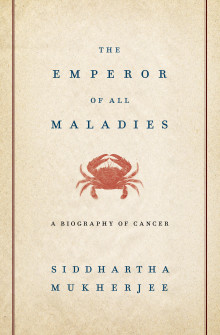
The Emperor of All Maladies, by Siddhartha Mukherjee. New York: Scribner, 2010.
It would seem to make sense that doctors start off with youthful emotion and then graduate to a self-protective distancing, but in his award-winning The Emperor of All Maladies: A Biography of Cancer, New York-based oncologist Mukherjee likewise speaks of being propelled willy-nilly into humanism: “I had never expected medicine to be such a lawless, uncertain world. I wondered if the compulsive naming of parts, diseases and chemical reactions – frenulum, otitis, glycolysis – was a mechanism invented by doctors to defend themselves against a largely unknowable sphere of knowledge.” Writing is a means to fight back against that defence. A doctor needs defences – but not too many. “It is an old complaint about the practice of medicine that it inures you to the idea of death,” Mukherjee writes. “But when medicine inures you to the idea of life, to survival, then it has failed utterly.” And elsewhere he observes: “Good physicians are rarely dispassionate. They agonise and self-doubt over patients.” He adds: “An efficient, thrumming, technically accomplished laboratory is like a robot orchestra that produces perfectly pitched tunes but no music.” Mukherjee chronicles his gradual revelation that while benevolence without discipline is an ineffective cure, precision without empathy is tone-deaf; his books, including the forthcoming The Gene: An Intimate History, can feel like overcompensation for the efficiency of his life as a physician.
How to bridge this gap? Part of it had to come from a study of what had gone before, but Mukherjee “had a novice’s hunger for history, but also a novice’s inability to envision it”. His books chronicle the emergence of that envisioning as he learned to reveal the vulnerability he shares with his patients. “Medicine … begins with storytelling,” he concludes. “Patients tell stories to describe illness; doctors tell stories to understand it. Science tells its own story to explain diseases.” In other words, explaining what is going on is part of the treatment itself.

When Breath Becomes Air, by Paul Kalanithi. New York: Random House, 2016.
Nowhere is that drama played out more explicitly than in the writing of a doctor who was himself a patient. Kalanithi, a neurosurgeon, wrote what will sadly be his only book, one about his reckoning with his own untimely mortality; he died at 37, and the final chapter of his bestselling memoir When Breath Becomes Air is by his widow. He describes how he resisted the human stories of his patients, acting “not … as death’s enemy, but as its ambassador”. Then came his own diagnosis. “My relationship with statistics changed as soon as I became one,” he explains. And that was a humanist revolution. “Science may provide the most useful way to organise empirical, reproducible data,” he writes, “but its power to do so is predicated on its inability to grasp the most central aspects of human life: hope, fear, love, hate, beauty, envy, honour, weakness, striving, suffering, virtue.” Kalanithi recognises how remarkable science is – and how limited. He defends its limitation, which is the necessary armour that allows a surgeon to go about his daily work. When objectivity breaks down, medicine ceases to function. And yet when objectivity reigns, human beings cease to function, because we are subjective in every breath we take.
If Kalanithi writes from the standpoint of an accelerated wisdom, Francis is still a fresh-faced novice, to borrow Mukherjee’s phrase. Francis writes of “a journey though the most intimate landscape of all: our own bodies”. But his journey through bodies has turned out to be a journey through souls as well. “What I didn’t bargain for were the stories,” Francis writes in Adventures in Human Being. Like the others, he seeks an escape from dualism. “Since Descartes we’ve had a tendency to believe that from the chin down we are just meat and plumbing … there is more to us than that … in some way we become aware when a valve is no longer working.” He describes his own work as “an exploration of life’s possibilities: an adventure in human being” in which we “charge our bodies with meaning, whether funny or solemn”. He describes “imagining the body as a mirror of the world that sustains us”. The body is our world, nothing less than that.

Adventures in Human Being, by Gavin Francis. London: Profile Books, 2015.
The exploration of the philosophical complexity that lies between sickness and health is perhaps the most urgent matter facing medicine and literature, because scientific definitions of illness often run up against humanist definitions of identity. I know whereof I speak: I have an identity that was long deemed an illness. The literature on homosexuality as a disease is amply represented in medical libraries, and it is my own history, even though I disbelieve it. The process through which gay identity was rescued from medical textbooks launched humanism’s upstaging of medicine. It reflects the common clinical presumption that variation from the norm constitutes pathology. When we define an illness, we have a grave effect on those who are subject to it. Alan Turing, Oscar Wilde and a panoply of less prominent gay people were brought up to know themselves as diseased to the very core, and so we lost much of their brilliance and their joy.
We face these questions about the boundaries of illness and health on a daily basis. What does it mean when we are exhorted to treat and so pathologise grief? What does it mean when my children get assessed by their schools and we are told that they have a little bit of ADD? Is it helpful to secure treatment, or is it better to bring them up thinking that they are whole just as they are? These issues are amply explored in Steve Silberman’s recent NeuroTribes, which makes the argument that autism is, like homosexuality, part of the variety in humanity that constitutes a rich world. But it surfaces repeatedly, because medicine’s inexactitude is a problem not only of primitive science, but also of a sometimes crude view of human beings. Literature about medicine may be all that can save us.
Most hospitals now provide translation services for people who are unable to speak in English. Those are a meaningful social service, important for the fair treatment of immigrants, deaf people and others who would be imprisoned in Babel without this access to unfettered communication. But translation is a crucial part of every doctor’s job. How to ensure that knowledge does not fall short of kindness? Hippocrates averred that mental illnesses in particular were problems of the brain best treated with oral remedies. Plato maintained that they were philosophical problems best resolved through dialogue. That opposition between biological and psychosocial models of consciousness is fought out by psychologists and psychiatrists around the globe. But it is not merely a question of mental illness; physical illness, too, is remedied in part by medication or surgery and in part by discourse. Marcel Proust, that infamous neurasthenic, wrote: “Three-quarters of the sicknesses of intelligent people comes from their intelligence. They need at least a doctor who can understand this sickness.” It is not simply that intelligence awakens the imagination to somaticised psychic distress in physical symptoms, but that illness has to be understood as both metaphor and reality. Verghese speaks of the aspects of cure that are achieved not with the hands but with the ear.
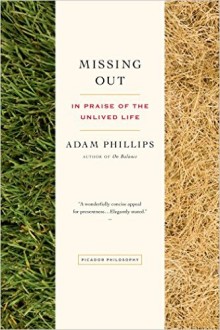
Missing Out: In Praise of the Unlived Life, by Adam Phillips. New York: Picador, 2013.
It seems winningly ambitious for a doctor to write; the role of an open spirit in a primarily technical discipline is subject to debate. In psychology, however, communication is the practice, and words are the medicine itself. Adam Phillips, our greatest writer on psychology, points out that the ambition of medicine is to know other people; the disappointing revelation of psychology is that this is impossible. In an article in the Threepenny Review, he explains that psychoanalysis “weans people from their compulsion to understand and be understood; it is an ‘after-education’ in not getting it”. In Missing Out: In Praise of the Unlived Life, he expands the idea, writing: “There is nothing we could know about ourselves or another that can solve the problem that other people actually exist, and we are utterly dependent on them … There is nothing to know apart from this, and everything else we know, or claim to know, or are supposed to know, or not know, follows on from this.” If we expect to be understood fully, he adds, we will be constantly disappointed – and then, “how could we ever be anything other than permanently enraged?” If Phillips’s message of accommodating incomprehension is pertinent to Eros, family and friends, it is likewise central to our interaction with the doctors who heal our bodies, or fail to do so. We want our doctors to understand us, and, in many ways, they never will, and accepting that frustration requires the literary language at which all the physicians mentioned in this article succeed.
Chekhov famously quipped: “Medicine is my lawful wife and literature my mistress; when I get tired of one, I spend the night with the other.” What is most striking among these writers is that they seem not to fluctuate between two practices, but to experience them as components of a coherent whole. Language itself is a physical act; it comes of neurons, of activation of Broca’s area and Wernicke’s area in the brain, of lips and tongues and throats that speak, hands that write or type. To treat it as a distracting adjunct to corporeality is to deny its nature.
The Bible reverts to metaphors of medicine because they are metaphors of identity: from the missing balm in Gilead to the raising of Lazarus to the ministrations of the Good Samaritan. The healing of the body is perhaps the greatest of the proven miracles; in Psalm 103, it is the Lord “who forgiveth all thine iniquities; who healeth all thy diseases”. Medicine can contribute to literature; narrative practice can strengthen medicine. It behoves writers and doctors to learn each other’s fluencies, because their disparate approaches can add up to singular truths.











